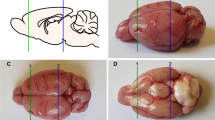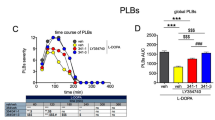Abstract
The neuropharmacologic mechanisms underlying neuroleptic-induced extrapyramidal syndromes (EPS) were studied using a nonhuman primate model. Twenty-six Cebus albifrons monkeys were given weekly challenges of haloperidol (0.025 mg/kg IM), and half of the animals received the monoamine oxidase (MAO) inhibitor pargyline (5 mg/kg PO) daily for 17 consecutive days during the protocol. Pargyline caused no changes in baseline behaviors, but significantly reduced haloperidol-induced acute dystonia (AD) (-67%, P<0.002) and parkinsonism (-56%, P<0.005). The majority (8 of 13) of the experimental group had complete prevention of neuroleptic-induced EPS during cotreatment with pargyline. Behavioral scores returned to baseline levels after stopping pargyline, and did not show the further sensitization to haloperidol-induced AD that occurred in the control group. The possible mechanisms by which an MAO inhibitor might influence neuroleptic-induced AD were considered. The most likely explanation would appear to involve facilitation of striatal dopamine (DA) neurotransmission by inhibition of intra- and extraneuronal MAO, thus supporting the hypothesis that AD is due to decreased striatal DA function with secondary cholinergic hyperfunction.
Similar content being viewed by others
References
Ayd FJ (1961) A survey of drug-induced extrapyramidal reactions. JAMA 75:1054–1060
Bacopoulos NG, Redmond DE, Balau J, Roth RH (1980) Chronic haloperidol or fluphenazine: effects on dopamine metabolism in brain, cerebrospinal fluid, and plasma of Cercopithecus aethiops (vervet monkey). J Pharmacol Exp Ther 212:1–5
Balsara JJ, Jadhav JH, Chandorkar AC (1979) Effects of drugs influencing central serotonergic mechanisms on haloperidol-induced catalepsy. Psychopharmacology 62:687–690
Bedard P, DeLean J, LaFleur J, Larochelle L (1977) Haloperidol-induced dyskinesias in the monkey. Can J Neurol Sci 4:197–201
Bowers MB, Gerbode FA (1968) Relationship of monoamine metabolites in human cerebrospinal fluid to age. Nature 219:1256–1257
Bucci L (1987) The negative symptoms of schizophrenia and the monoamine oxidase inhibitors. Psychopharmacology 91:104–108
Burns RS, Chiveh CC, Markey S, Ebert MH, Jacobowitz D, Kopin IJ (1983) A primate model of parkinsonism: selective destruction of dopaminergic neurons in the pars compacta of the substantia nigra by N-methyl-4-phenyl-1,2,3,6-tetrahydropyridine. Proc Natl Acad Sci USA 80:4546–4550
Campbell IC, Robinson DS, Lovenberg W, Murphy DL (1979) The effects of chronic regimens of clorgyline and pargyline on monoamine metabolism in the rat brain. J Neurochem 12:49–55
Casey DE, Gerlach J, Christensson E (1980) Dopamine, acetylcholine, and GABA effects in acute dystonia in primates. Psychopharmacology 70:83–87
Chiba K, Trevor A, Castagnol N (1984) Metabolism of the neurotoxic tertiary amine, MPTP, by brain monoamine oxidase. Biochem Res Commun 120:574–578
Cools AR, Hendricks G, Korten J (1974) The acetylcholine-dopamine balance in the basal ganglia of rhesus monkeys and its role in dynamic, dystonic, dyskinetic, and epileptoid motor activities. J Neural Transm 36:91–105
Creese I, Burt DR, Snyder SH (1976) Dopamine receptor binding predicts clinical and pharmacological potencies of antischizophrenic drugs. Science 192:481–483
DiMascio A, Bernardo DL, Greenblatt DJ, Marder JE (1976) A controlled trial of amantadine in drug-induced extrapyramidal disorders. Arch Gen Psychiatry 33:599–602
Fowler CJ, Callingham BA, Mantle TJ, Tipton KF (1978) Monoamine oxidase A and B: a useful concept? Biochem Pharmacol 27:97–101
Garrick NA, Murphy DL (1980) Species differences in the deamination of dopamine and other substrates for monoamine oxidase in brain. Psychopharmacology 72:27–33
Garrick NA, Redmond DE, Murphy DL (1979) Primate-rodent monoamine oxidase differences: In: Singer TP, Von Korff RW, Murphy DL (eds) Monoamine oxidase: structure, function, and altered functions. Academic, New York, pp 351–359
Gessa R, Tagliamonte T, Gessa GL (1972) Blockade by apomorphine of haloperidol-induced dyskinesia in schizophrenic patients. Lancet II:981–982
Gunne L-M, Barany S (1976) Haloperidol-induced tardive dyskinesia in monkeys. Psychopharmacology 50:237–240
Karson CN (1983) Spontaneous eye-blink rates and dopaminergic systems. Brain 106:643–653
Keepers GA, Casey DE (1986) Prediction of neuroleptic-induced dystonia. J Clin Psychopharmacol (in press)
Kolbe H, Clow A, Jenner P, Marsden CD (1981) Neuroleptic-induced acute dystonic reactions may be due to enhanced dopamine release onto supersensitive postsynaptic receptors. Neurology 31:434–439
Korsgaard S, Gerlach J, Christensson E (1985) Behavioral aspects of serotonin-dopamine interaction in the monkey. Eur J Pharmacol 118:245–252
Kovacic B, Domino E (1984) Fluphenazine-induced acute and tardive dyskinesias in monkeys. Psychopharmacology 84:310–314
Langston JW, Forno LS, Rebert CS, Irwin I (1984a) Selective nigral toxicity after systemic administration of (MPTP) in the squirrel monkey. Brain Res 292:390–394
Langston JW, Irwin I, Langston EB, Forno LS (1984b) Pargyline prevents MPTP-induced parkinsonism in primates. Science 225:1480–1482
Liebman J, Neale R (1980) Neuroleptic-induced acute dyskinesias in squirrel monkeys: correlation with propensity to cause extrapyramidal side effects. Psychopharmacology 68:25–29
Magelund G, Gerlach J, Casey DE (1979) Neuroleptic-potentiating effect of alpha-methyl-p-tyrosine compared with haloperidol and placebo in a double-blind crossover trial. Acta Psychiatr Scand 60:185–189
Major LF, Murphy DL, Lipper S, Gordon E (1979) Effects of clorgyline and pargyline on deaminated metabolites of norepinephrine, dopamine, and serotonin in human cerebrospinal fluid. J Neurochem 32:229–231
Marsden CD, Jenner P (1980) The pathophysiology of extrapyramidal side-effects of neuroleptic drugs. Psychol Med 10:55–72
McGeer E, McGeer PL (1976) Neurotransmitter metabolism in the aging brain. In: Terry RD, Gershon S (eds) Neurobiology of aging. Raven, New York, pp 389–403
Meldrum BS, Anlezark G, Marsden CD (1977) Acute dystonia as an idiosyncratic response to neuroleptics in baboons. Brain 100:313–326
Murphy DL, Dill RE (1972) Chemical stimulation of discrete brain loci as a method of producing dyskinesia models in primates. Exp Neurol 34:244–254
Murphy DL, Kalin NH (1980) Biological and behavioral consequences of alterations in monoamine oxidase activity. Schizophr Bull 6:355–367
Murphy DL, Redmond DE, Garrick NA, Baulu J (1979) Brain region differences and some characteristics of monoamine oxidase type A and B activities in the vervet monkey. Neurochem Res 4:53–62
Murphy DL, Garrick NA, Aulakh CS, Cohen RM (1984) New contributions from basic science to understanding the effects of monoamine oxidase inhibiting antidepressants. J Clin Psychiatry 45:37–43
Neale R, Gerhardt S, Liebman J (1984) Effects of dopamine agonists, catecholamine depletors, and cholinergic and GABAergic drugs on acute dyskinesias in squirrel monkeys. Psychopharmacology 82:20–26
Parkes JD, Bedard P, Marsden CO (1976) Chorea and torsion in parkinsonism. Lancet I:155
Paulson GW (1973) Dyskinesias in monkeys. In: Huntington's chorea. Advances in Neurology, Vol. 1. Raven, New York, pp 647–650
Peroutka SJ, Snyder SH (1980) Long-term antidepressant treatment decreases spiroperidol-labeled serotonin receptor binding. Science 210:88–90
Porsolt R, Jalfre M (1981) Neuroleptic-induced acute dyskinesias in rhesus monkeys. Psychopharmacology 75:16–21
Post RM, Goodwin FK (1975) Time-dependent effects of phenothiazines on dopamine turnover in psychiatric patients. Science 190:488–489
Povlsen UJ, Noring U, Laursen AL, Korsgaard S, Gerlach J (1986) The effects of serotonergic and anticholinergic drugs in haloperidol-induced dystonia in cebus monkeys. Clin Neuropsychol Pharmacol 9(1):84–90
Riederer P, Wuketich S (1976) Time course of nigrostriatal degeneration in Parkinson's disease. J Neural Transm 38:277–301
Robinson DS, Campbell IC, Walker M, Statham NJ, Lovenberg W, Murphy DL (1979) Effects of chronic monoamine oxidase inhibitor treatment on biogenic amine metabolism in rat brain. Neuropharmacology 18:771–776
Robinson DS, Nies A, Davis JN, Bunney WE, Davies JM, Colburn RW, Bourne HR, Shaw DM, Coppen AJ (1972) Ageing, monoamines, and monoamine oxidase levels. Lancet I:290–291
Sethy VH, Von Woert MH (1974) Modification of striatal acetylcholine concentration by dopamine receptor agonists and antagonists. Res Commun Chem Pathol Pharmacol 8:13–28
Sassin JF (1975) Drug-induced dyskinesia in monkeys. In: Meldrum BS, Marsden CD (eds) Primate models of neurological disorders. Advances in Neurology, Vol. 10. Raven, New York, pp 47–54
Snyder SH, Yamamura HI (1977) Antidepressants and the muscarinic acetylcholine receptor. Arch Gen Psychiatry 34:236–239
Snyder SH, D'Amato RJ (1986) MPTP: a neurotoxin relevant to the pathophysiology of Parkinson's disease. Neurology 36:250–258
Stockhausen DF (1960) Clinical studies with tetrabenazine (RO1–9569). Dis Nerv Syst 21:321–328
Tryding N, Tufvesson G, Nilsson S (1972) Ageing, monoamines, and monoamine oxidase levels (letter to the editor). Lancet I:4899
Weiss B, Santelli S, Lusink G (1977) Movement disorders induced in monkeys by chronic haloperidol treatment. Psychopharmacology 53:289–293
Youdim MBH, Riederer P, Birkmayer W, Mendlewicz J (1979) The functional activity of monoamine oxidase: the use of deprenyl in the treatment of Parkinson's disease and depressive illness. In: Singer TP, Von Korff RW, Murphy DL (eds) Monoamine oxidase: structure, function, and altered functions. Academic, New York, pp 477–496
Author information
Authors and Affiliations
Rights and permissions
About this article
Cite this article
Heintz, R., Casey, D.E. Pargyline reduces/prevents neuroleptic-induced acute dystonia in monkeys. Psychopharmacology 93, 207–213 (1987). https://doi.org/10.1007/BF00179935
Revised:
Issue Date:
DOI: https://doi.org/10.1007/BF00179935




